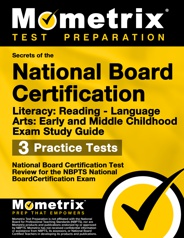The National Board for Professional Teaching Standards (NBPTS) Certification aims to develop, retain, and recognize accomplished educators while encouraging school improvement nationwide. The Early and Middle Childhood/Literacy: Reading-Language Arts exam is for those who wish to teach reading and language arts to children ages 3-12.
Click “Start Test” above to take a free EMC/Literacy: Reading-Language Arts practice test, and check out our premium-quality test prep resources by clicking the links below!
Exam Eligibility
To be eligible for this exam, you must meet the following requirements:
- You must hold a bachelors degree from an accredited institution
- You must have completed at least three years of successful teaching in one or more early childhood, elementary, middle, or secondary schools
- You must have held a valid state teaching license for each of the three years of verified teaching employment
Part-time and long-term substitution teaching counts toward the three-year employment requirement as long as you ALSO hold a valid state teaching license and the time computation follows those outlined in the eligibility guidelines.
NBPTS allows those who haven’t met the three-year experience requirement to begin the application process as long as they fulfill this requirement by the end of their application process.
Certification Components
The Reading-Language Arts exam consists of four components.
Components 2-4 are part of your portfolio that you submit online.
All four components are required for certification.
- Component 1: Content Knowledge. This is the computer-based assessment where you demonstrate your understanding of knowledge and pedagogical practices in your content area.
- Component 2: Differentiation in Instruction. This portfolio entry will include selected work samples that demonstrate student growth and a written commentary where you analyze your instructional choices.
- Component 3: Teaching Practice and Learning Environment. This portfolio entry requires video recordings of your classroom engagement and a written commentary describing, analyzing, and reflecting on your interactions.
- Component 4: Effective and Reflective Practitioner. This portfolio entry requires you to demonstrate your abilities to develop and apply knowledge of your students, your ability to use assessments to plan and impact student learning, and your collaborative efforts to advance student learning and growth.
The testing window for Component 1 ranges from the beginning of March to the middle of June. The submission window for your portfolio components goes from the beginning of April to the middle of May.
Check Out Mometrix's National Board Certification Study Guide
Get practice questions, video tutorials, and detailed study lessons
Get Your Study Guide
Details of Component 1: The Exam
Component 1 of the certification process is a computer-based assessment that measures your knowledge of the teaching content area and its appropriate teaching practices. You must demonstrate your knowledge in creating developmentally appropriate content that can be applied and adapted across the full age range and ability level of the certification you are applying for.
The computer-based assessment consists of 45 selected-response questions and three constructed-response exercises. The selected-response section is timed at one hour, followed by a 10-minute break. The constructed-response section is timed at 1.5 hours.
Selected-Response Section
The selected-response questions cover the following content areas in the approximate percentages listed:
Knowledge of Learners and Collaborating with Families (20%)
- Knowing each student as an intellectual, emotional, cultural, and social language learner
- Understanding learning and child development theories
- Assisting families in supporting the learning development of their children
Equity, Fairness, and Diversity; the Learning Environment; and Literacy Assessment (25%)
- Promoting fairness and equity
- Establishing the intellectual environment
- Selecting resources
- Selecting and administering assessments
Reading and Writing (20%)
- Knowledge and instruction of reading
- Knowledge and instruction of writing
- Connections of reading and writing to the other language arts and to other disciplines
Listening and Speaking; Viewing and Visual Literacy (35%)
- Knowledge and instruction of listening and speaking
- Knowledge and instruction of viewing and visual literacy
Constructed-Response Section
There are three exercises in the constructed-response section. You are allowed 30 minutes for each exercise, consisting of one or more prompts or questions.
A scenario or student profile is presented for you to consider when you answer the prompts relating to the information. Be sure to follow the directions in the prompt and answer only what is asked. The scoring assessors only evaluate your responses relating to the question or prompt. For example, if you are asked to provide two examples, do not provide three. You will waste valuable time, and the assessors will only evaluate the first two examples.
Your responses are judged on the depth and quality of your answers—grammar, punctuation, and organization are essential.
For this exercise, you will be asked to analyze a transcript of a student’s oral reading, identify two significant patterns pertaining to reading miscues and/or fluency, and discuss an appropriate teaching strategy to address one of the identified patterns.
Exercise 2: Writing Development
For this exercise, you will be asked to identify an area of strength and an area of need in a given writing sample and describe a developmentally appropriate teaching strategy to address each of them.
Exercise 3: Literacy Across the Curriculum
For this exercise, you will be asked to integrate literacy and content-area learning. Using the provided text, you will be asked to create a learning experience that effectively supports the development of literacy strategies and content knowledge.
Exam Registration
To register for the exam, you must create an account using the National Board Candidate Management System (NBCMS). This will begin the certification process and purchase components. There is a $75 registration fee for every cycle year that must be paid before you can purchase a component.
Once you have registered, make sure to take note of the deadlines for registration, taking an exam, and submitting the requirements and portfolios. These deadlines vary yearly but generally, registration and component selection is open from July to February of the following year. The testing window for Component 1 is from March to June, portfolio submission is from April to mid-May, and the release of scores will be in December.
Fees
The fee for each component is $475, making the total cost of the certification process $1,900. You can pay for the full fee in one go or spread out the payment over the three years of application. Keep in mind that you need to pay the additional $75 registration fee to maintain your online account.
NBPTS offers a payment plan that divides the cost of your certification over six equal payments, and financial aid may be available from your state or district.
Scheduling the Component 1 Assessment
Once registration for Component 1 is done, you will receive an email notification to schedule an exam appointment on the affiliated Pearson VUE website. The website also provides a tutorial experience to help prepare yourself better for the exam.
Test Day
On test day, you should arrive at the testing center about 30 minutes before the start of the assessment. If you arrive later than 30 minutes after your scheduled exam time, you will not be allowed to enter the test venue.
You must bring a valid government-issued identification card that contains your photo, signature, and a name that matches the name you used when applying for the exam.
Before the exam begins, you will be required to sign an NDA to maintain the integrity of the exam. You will then be provided a test booklet and pencils for the constructed response portion. An online scientific calculator on your computer will be available during the exam.
How the Exam is Scored
For Component 1, selected-response questions answered correctly will be given one point. Your total raw score will be converted to a rubric score scale from 0 to 4.25. For the constructed-response questions (as well as Components 2, 3, and 4), your score will be assessed using a 12-point rubric score scale that ranges from 0.75 to 4.25.
To achieve certification, you must achieve a score of 2.75 on all components, signifying clear evidence of accomplished teaching practice. The absolute minimum average scores you can achieve for all components are 1.75, with a total weighted scaled score of at least 110. However, these latter scores do not guarantee an NBPTS certification compared to achieving the earlier score of 2.75.
If you pass all components, you will be eligible for board certification. Make sure to keep in touch with the NBPTS and update any contact information on your NBPTS account so they can communicate important information with you.
Retaking the Exam
If you fail to achieve a passing score on any of the components, you are allowed to retake each of them up to two times within two years.
Check Out Mometrix's National Board Certification Flashcards
Get complex subjects broken down into easily understandable concepts
Get Your Flashcards
FAQs
Q
What is the National Board Certification?
A
The National Board Certification is an advanced professional certification for PreK-12 educators, provided by the National Board for Professional Teaching Standards (NBPTS). The certification identifies teaching expertise through assessments that are performance-based and peer-reviewed.
Q
Can I retake the National Board Certification exam?
A
You can retake the exam during a two-year window, up to two times each.
Q
What is a passing score on the National Board Certification?
A
A passing score on the assessment component of the Early and Middle Childhood/Literacy: Reading-Language Arts exam is 2.75. A passing score for each of the portfolio components is also 2.75.
Q
How long is the National Board Certification?
A
The Early and Middle Childhood/Literacy: Reading-Language Arts exam is timed at 2.5 hours, with a 10-minute break between sections.
Q
How much does the National Board Certification exam cost?
A
The fee for each component is $475, making the total cost of certification $1,900 (not including the $75 registration fee).
Q
When will I receive my test scores?
A
You will receive your test scores around the second week in December.
